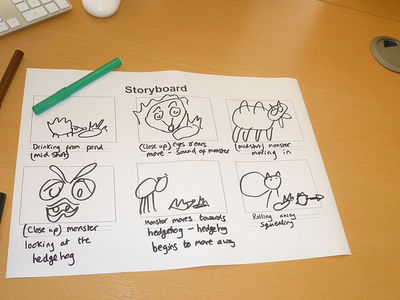EDT4OL/Storyboard/Introduction
The origins of storyboarding are within the film industry, where it was popularised by Walt Disney Productions during the early 1930s. In this context, a storyboard is a graphic organiser in the form of images displayed in sequence, to pre-visualise a motion picture, animation or interactive media sequence.
Example of a mini-course level storyboard
The following storyboard example provides a visual overview of a four-week course, including the learning resources and activities for achieving the learning outcomes, as well as an assessment strategy for both formative and summative assessment[1].
In this example, the four columns represent four weeks, with one topic focus per week:
- During week 1, learners watch a video and read a paper to complete an e-tivity (online activity) and write an essay, which is assessed. The teacher provides formative feedback.
- In week 2, learners listen to a podcast, read a paper and write a reflective blog post. Other learners comment on this post.
- In weeks 3-4, learners read more papers, listen to a podcast and watch a video. They might do a group presentation and write an essay. The teacher undertakes a summative assessment.
In practice, storyboards are developed using a variety of tools, from flipcharts to web-based technologies.
Acknowledgement
- ↑ The original version of these materials was developed by Gabi Witthaus and Brenda Padilla for the Storyboard for Storyboarding open course under a CC-BY-SA licence.

